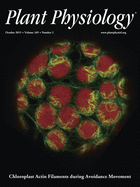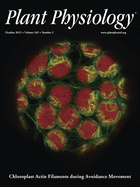
Cover image

On the Cover: Chloroplast movement is mediated by the actin cytoskeleton. The chloroplast-actin (cp-actin) filaments that are specifically localized on the chloroplast envelope are rapidly reorganized according to the intensity and position of incident blue light. Suetsugu et al. (pp. 1155–1167) showed that PLASTID MOVEMENT IMPAIRED1 (PMI1) mediates chloroplast photorelocation movement via the regulation of cp-actin filaments and is essential for nuclear photorelocation movement in Arabidopsis (Arabidopsis thaliana) mesophyll cells. PMI1 and the homolog PLASTID MOVEMENT IMPAIRED1-RELATED1 are required for photorelocation movements of both plastids and nuclei in Arabidopsis pavement cells. The cover shows the cp-actin filament distribution at the rim of the chloroplasts during avoidance response in reaction to strong blue light focused on the central part of the cell. Cover image credits: Sam-Geun Kong, Kyushu University, Japan.
Volume 169, Issue 2, October 2015
ON THE INSIDE
On the Inside
EDITORIAL
Vigilante Science
COMMENTARIES
Visualizing the Photosynthetic Membrane Proteins in Situ: Atomic Force Microscopy
Nutrient Signaling by Nitrate and Calcium
From Leaf to Kernel: Trehalose-6-Phosphate Signaling Moves Carbon in the Field
Seed-specific expression of a rice TPP in maize promotes yield in the field.
TOPICAL REVIEW
Living to Die and Dying to Live: The Survival Strategy behind Leaf Senescence
Leaf senescence is a highly dynamic process that has a major impact on crop production and quality.
BREAKTHROUGH TECHNOLOGIES
Targeted Mutagenesis, Precise Gene Editing, and Site-Specific Gene Insertion in Maize Using Cas9 and Guide RNA
Genome editing and gene insertion in maize is advanced with Cas9-guide RNA technology.
Application of Optical Topometry to Analysis of the Plant Epidermis
Optical topometry is a powerful, nondestructive method for rapid, quantitative, high resolution imaging of the plant epidermis, requiring no sample preparation.
Cas9-Guide RNA Directed Genome Editing in Soybean
High-frequency and heritable targeted mutagenesis, transgene integration, and endogenous gene editing in soybean is realized using CRISPR Cas9-gRNA.
A CRISPR/Cas9 Toolbox for Multiplexed Plant Genome Editing and Transcriptional Regulation
A CRISPR/Cas9 toolbox enables multiplex genome editing and transcriptional regulation of genes in plants.
RESEARCH REPORTS
Direct Recording of Trans-Plasma Membrane Electron Currents Mediated by a Member of the Cytochrome b561 Family of Soybean
Electron currents mediated by a soybean cytochrome b561 protein are detected and functionally characterized using a classical electrophysiological approach.
SCIENTIFIC CORRESPONDENCE
On the Extent of Tyrosine Phosphorylation in Chloroplasts
Reanalysis of published mass spectrometry data on Tyr-phosphorylated chloroplast proteins indicates that the majority of peptide spectrum matches reporting Tyr phosphorylation are ambiguous.
Tryptophan-Independent Indole-3-Acetic Acid Synthesis: Critical Evaluation of the Evidence
Evidence for Trp-independent IAA synthesis is critically reevaluated in the light of tryptophan synthase proteome data, local IAA synthesis and Trp, indole-3-pyruvate, and IAA turnover.
UPDATES
Analysis of Small Ubiquitin-Like Modifier (SUMO) Targets Reflects the Essential Nature of Protein SUMOylation and Provides Insight to Elucidate the Role of SUMO in Plant Development
Analysis of the mechanisms, regulation, and consequences of protein SUMOylation in plants and other eukaryotes highlights the conservation and importance of this process across taxa.
Cellular Signaling Pathways and Posttranslational Modifications Mediated by Nematode Effector Proteins
Plant-parasitic nematodes produce a diverse arsenal of effector proteins that interfere with defined cellular processes in host plants to promote successful parasitism.
Articles
BIOCHEMISTRY AND METABOLISM
Salt-Related MYB1 Coordinates Abscisic Acid Biosynthesis and Signaling during Salt Stress in Arabidopsis
A salt-related transcription factor regulates abscisic acid synthesis and signaling genes in germinating Arabidopsis seeds under saline conditions.
GLYCOLATE OXIDASE3, a Glycolate Oxidase Homolog of Yeast l-Lactate Cytochrome c Oxidoreductase, Supports l-Lactate Oxidation in Roots of Arabidopsis
A glycolate oxidase metabolizes l-lactate to pyruvate in vivo and may ensure the maintenance of low levels of l-lactate after its formation under normoxia.
Regulation of Nicotine Biosynthesis by an Endogenous Target Mimicry of MicroRNA in Tobacco
Endogenous target mimecry of an miRNA affects nicotine biosynthesis.
Differential Role for Trehalose Metabolism in Salt-Stressed Maize
Salt treatment of maize increased the sugar sensing metabolite trehalose-6-phosphate, as well as sucrose and hexose sugars, leading to reductions in spikelet growth, silk growth and kernel set.
The Identification of Maize and Arabidopsis Type I FLAVONE SYNTHASEs Links Flavones with Hormones and Biotic Interactions
Two novel flavone synthase enzymes from maize and Arabidopsis integrate flavone metabolism with hormone and biotic stress responses.
Overexpression of Arabidopsis Ceramide Synthases Differentially Affects Growth, Sphingolipid Metabolism, Programmed Cell Death, and Mycotoxin Resistance
Overexpression of ceramide synthases has strongly divergent physiological and metabolic effects with implications for improved plant performance.
Methylated Cytokinins from the Phytopathogen Rhodococcus fascians Mimic Plant Hormone Activity
Methylated cytokinins contribute to pathogenesis as hormone-mimics.
Isolation and Characterization of O-methyltransferases Involved in the Biosynthesis of Glaucine in Glaucium flavum
A subset of multifunctional O-methyltransferases is involved in the formation of the tetra-O-methylated benzylisoquinoline alkaloid glaucine.
CELL BIOLOGY
Ligand-Mediated cis-Inhibition of Receptor Signaling in the Self-Incompatibility Response of the Brassicaceae
Coexpression of the receptor and ligand that function in crucifer self-incompatibility inhibits receptor signaling and abrogates the ability of stigma epidermal cells to arrest self pollen.
PLASTID MOVEMENT IMPAIRED1 and PLASTID MOVEMENT IMPAIRED1-RELATED1 Mediate Photorelocation Movements of Both Chloroplasts and Nuclei
Two C2 domain proteins regulate light-mediated movements of plastids and nuclei in both mesophyll and pavement cells.
Distinct Cellular Locations of Carbonic Anhydrases Mediate Carbon Dioxide Control of Stomatal Movements
Intracellular targeting of guard cell carbonic anhydrases is characterized and modeled in relation to their roles in CO2 control of stomatal movements.
Rice TUTOU1 Encodes a Suppressor of cAMP Receptor-Like Protein That Is Important for Actin Organization and Panicle Development
An actin nucleation protein affects rice panicle development as well as root growth.
ECOPHYSIOLOGY AND SUSTAINABILITY
High-Resolution Three-Dimensional Structural Data Quantify the Impact of Photoinhibition on Long-Term Carbon Gain in Wheat Canopies in the Field
A digital reconstruction method models the effect of photoinhibition on daily canopy photosynthesis in three contrasting wheat canopies.
Stomatal Blue Light Response Is Present in Early Vascular Plants
Blue light responses of stomata occur in a wide lineage of plants except the fern species of Polypodiopsida.
GENES, DEVELOPMENT, AND EVOLUTION
SHORT VEGETATIVE PHASE Up-Regulates TEMPRANILLO2 Floral Repressor at Low Ambient Temperatures
The functional characterization of two Arabidopsis floral repressors unravels their role and regulation at low ambient temperatures.
EARLY SENESCENCE1 Encodes a SCAR-LIKE PROTEIN2 That Affects Water Loss in Rice
An actin nucleation protein affects water loss by regulating stomatal density.
Meta-Analysis of Arabidopsis KANADI1 Direct Target Genes Identifies a Basic Growth-Promoting Module Acting Upstream of Hormonal Signaling Pathways
The comparative study of the gene targets of the KANADI1 transcription factor indicates that it is part of a basic growth-promoting module.
Convergent Evolution of Endosymbiont Differentiation in Dalbergioid and Inverted Repeat-Lacking Clade Legumes Mediated by Nodule-Specific Cysteine-Rich Peptides
Several species from an ancient legume lineage independently evolved a novel class of cysteine-rich peptides to impose a differentiation process on their endosymbionts.
Second-Site Mutagenesis of a Hypomorphic argonaute1 Allele Identifies SUPERKILLER3 as an Endogenous Suppressor of Transgene Posttranscriptional Gene Silencing
Addressing RNAs to the 3′-to-5′ exoribonuclease of the cytoplasmic exosome counteracts posttranscriptional transgene silencing.
SENESCENCE-SUPPRESSED PROTEIN PHOSPHATASE Directly Interacts with the Cytoplasmic Domain of SENESCENCE-ASSOCIATED RECEPTOR-LIKE KINASE and Negatively Regulates Leaf Senescence in Arabidopsis
A protein phosphatase negatively regulates Arabidopsis leaf senescence through dephosphorylating a senescence-promoting receptor-like kinase.
MEMBRANES, TRANSPORT, AND BIOENERGETICS
Genetic and Physical Interaction Studies Reveal Functional Similarities between ALBINO3 and ALBINO4 in Arabidopsis
A thylakoid membrane protein shares functional similarity and physical interactions with the homologous protein insertase, despite sequence-level divergence in a critical C-terminal domain.
Lack of Phosphatidylglycerol Inhibits Chlorophyll Biosynthesis at Multiple Sites and Limits Chlorophyllide Reutilization in Synechocystis sp. Strain PCC 6803
The lack of lipid phosphatidylglycerol inhibits chlorophyll biosynthesis and induces accumulation of an aberrant protein complex containing monomeric PSI and CP43 antenna of PSII.
The Use of Contact Mode Atomic Force Microscopy in Aqueous Medium for Structural Analysis of Spinach Photosynthetic Complexes
Characterization of spinach grana membranes by contact mode atomic force microscopy in aqueous medium distinguishes molecular features and the distribution of the lumen-exposed domains of PSII.
Overexpression of BAX INHIBITOR-1 Links Plasma Membrane Microdomain Proteins to Stress
Overexpression of a cell death suppressor modulates sphingolipid and protein composition of plasma membrane microdomains, leading to enhanced tolerance to stress.
Phosphorylation and Dephosphorylation of the Presequence of Precursor MULTIPLE ORGANELLAR RNA EDITING FACTOR3 during Import into Mitochondria from Arabidopsis
Phosphorylation of the presequence of an RNA editing factor by cytosolic kinases and its dephosphorylation by an outer mitochondrial membrane phosphatase contribute to mitochondrial import of the factor protein.
SIGNALING AND RESPONSE
Changes in the Common Bean Transcriptome in Response to Secreted and Surface Signal Molecules of Rhizobium etli
Transcriptional profiling of common bean roots exposed to rhizobial molecules uncovers unique aspects of root nodule symbiosis, including early modulation of genes encoding circadian clock components.
Overaccumulation of γ-Glutamylcysteine in a Jasmonate-Hypersensitive Arabidopsis Mutant Causes Jasmonate-Dependent Growth Inhibition
The glutathione precursor γ-glutamylcysteine modulates plant growth inhibition by the jasmonate hormone.
Drought Induces Distinct Growth Response, Protection, and Recovery Mechanisms in the Maize Leaf Growth Zone
Drought inhibits cell division and expansion in the maize leaf growth zone by reducing antioxidant levels and increases photosynthetic capacity to allow for enhanced growth upon recovery.
The Calcium Ion Is a Second Messenger in the Nitrate Signaling Pathway of Arabidopsis
Nitrate sensed by the NRT1.1/NPF6.3 nitrate transceptor activates a PLC activity which causes an increase in the concentration of cytoplasmic Ca2 + and stimulates expression of nitrate responsive genes.
The RING E3 Ligase KEEP ON GOING Modulates JASMONATE ZIM-DOMAIN12 Stability
An E3 ubiquitin ligase involved in abscisic acid signaling modulates the stability of a central jasmonate signaling component.


